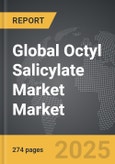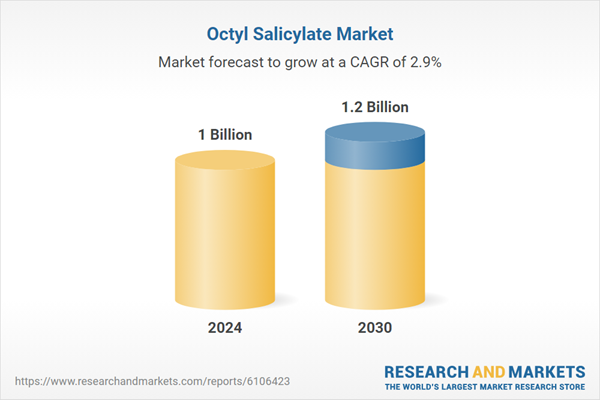Global Octyl Salicylate Market - Key Trends & Drivers Summarized
Why Is Octyl Salicylate Gaining Importance in UV Protection Formulations?
Octyl salicylate is a widely used organic compound in personal care and cosmetic products, especially sunscreens. It functions primarily as a UVB filter, helping protect the skin from the harmful effects of ultraviolet radiation. Its ability to absorb UVB rays and enhance the stability of other photo-protective agents makes it a preferred ingredient in multi-component sunscreen formulations. Octyl salicylate is often used in conjunction with other filters such as avobenzone or octocrylene to broaden and strengthen the UV protection spectrum.In addition to its UV absorption properties, octyl salicylate contributes emollient effects that support skin hydration and smooth application. Its compatibility with various formulation bases, including creams, sprays, and gels, makes it suitable for a wide range of products beyond sunscreens, including daily moisturizers, lip balms, and anti-aging products with SPF claims. As consumer awareness of sun damage and photoaging grows, the demand for products containing octyl salicylate is steadily rising.
How Are Regulatory and Safety Factors Influencing Its Market Usage?
Octyl salicylate is generally regarded as safe for topical use in concentrations up to 5%, as approved by multiple regulatory agencies. It has a low sensitization and irritation profile, making it suitable for sensitive skin formulations. However, increasing scrutiny over UV filters and their environmental and systemic safety is prompting more careful formulation strategies and transparent labeling in the personal care industry.Some regions are implementing more stringent evaluation frameworks for sunscreen ingredients, requiring companies to demonstrate both safety and efficacy over extended use. While octyl salicylate remains approved in most key markets, manufacturers are prioritizing sourcing of high-purity grades and ensuring compliance with evolving regulatory guidance. Clean-label and reef-safe claims are also influencing ingredient selection, encouraging balanced use with other environmentally friendly components.
What Industry Trends Are Supporting Expansion Across Product Categories?
Consumer interest in daily sun protection, skincare-makeup hybrids, and multifunctional cosmetic products is expanding the application of octyl salicylate beyond traditional sun care. It is increasingly used in facial moisturizers, tinted creams, foundations, and BB creams where SPF inclusion is important but non-greasy feel and cosmetic elegance must be preserved. The demand for lightweight, transparent sun protection is also driving interest in formulations with octyl salicylate, which supports these characteristics.In emerging markets, rising middle-class populations and improved skincare awareness are increasing the demand for affordable and effective sun care products. Octyl salicylate's relatively low cost and proven efficacy make it an attractive option for mass-market and private-label formulations. Seasonal product demand, particularly in travel, outdoor recreation, and beach tourism categories, continues to reinforce its role in wide-ranging product development cycles.
Growth in the octyl salicylate market is driven by several factors.
Increasing awareness of UV-related skin damage and a growing preference for daily-wear SPF products are driving formulation demand. Compatibility with other filters and its role in enhancing product texture and spreadability make octyl salicylate a valuable component in multifunctional skincare and cosmetic products. Regulatory acceptance in major markets and its favorable safety profile support continued use. Growth in personal care manufacturing in emerging economies, coupled with innovations in lightweight and transparent sunscreen formats, is broadening the ingredient's reach across demographic segments and product categories.Report Scope
The report analyzes the Octyl Salicylate market, presented in terms of market value (US$). The analysis covers the key segments and geographic regions outlined below:- Segments: Appearance (Colorless Appearance, Light Yellow Appearance); Application (Perfume Application, Soap Application, Cosmetics Application, Sunscreens Application, Other Applications).
- Geographic Regions/Countries: World; United States; Canada; Japan; China; Europe (France; Germany; Italy; United Kingdom; Spain; Russia; and Rest of Europe); Asia-Pacific (Australia; India; South Korea; and Rest of Asia-Pacific); Latin America (Argentina; Brazil; Mexico; and Rest of Latin America); Middle East (Iran; Israel; Saudi Arabia; United Arab Emirates; and Rest of Middle East); and Africa.
Key Insights:
- Market Growth: Understand the significant growth trajectory of the Colorless Appearance segment, which is expected to reach US$807.7 Million by 2030 with a CAGR of a 2.1%. The Light Yellow Appearance segment is also set to grow at 4.4% CAGR over the analysis period.
- Regional Analysis: Gain insights into the U.S. market, valued at $280 Million in 2024, and China, forecasted to grow at an impressive 5.3% CAGR to reach $235.3 Million by 2030. Discover growth trends in other key regions, including Japan, Canada, Germany, and the Asia-Pacific.
Why You Should Buy This Report:
- Detailed Market Analysis: Access a thorough analysis of the Global Octyl Salicylate Market, covering all major geographic regions and market segments.
- Competitive Insights: Get an overview of the competitive landscape, including the market presence of major players across different geographies.
- Future Trends and Drivers: Understand the key trends and drivers shaping the future of the Global Octyl Salicylate Market.
- Actionable Insights: Benefit from actionable insights that can help you identify new revenue opportunities and make strategic business decisions.
Key Questions Answered:
- How is the Global Octyl Salicylate Market expected to evolve by 2030?
- What are the main drivers and restraints affecting the market?
- Which market segments will grow the most over the forecast period?
- How will market shares for different regions and segments change by 2030?
- Who are the leading players in the market, and what are their prospects?
Report Features:
- Comprehensive Market Data: Independent analysis of annual sales and market forecasts in US$ Million from 2024 to 2030.
- In-Depth Regional Analysis: Detailed insights into key markets, including the U.S., China, Japan, Canada, Europe, Asia-Pacific, Latin America, Middle East, and Africa.
- Company Profiles: Coverage of players such as Alliance Therapy Services, Amedisys, Inc., Anthem, Inc., Bayada Home Health Care, Care Patron and more.
- Complimentary Updates: Receive free report updates for one year to keep you informed of the latest market developments.
Some of the 34 companies featured in this Octyl Salicylate market report include:
- Aako BV
- Aceto Corporation
- Alfresa Pharma Corporation
- Ashland Global Holdings Inc.
- BASF SE
- Bell Flavors & Fragrances Inc.
- Clariant AG
- Croda International Plc
- DSM (Koninklijke DSM N.V.)
- Eastman Chemical Company
- Evonik Industries AG
- Givaudan SA
- International Flavors & Fragrances (IFF)
- Kao Corporation
- Lubrizol Corporation
- Mane SA
- Merck KGaA
- Symrise AG
- Stepan Company
- Takasago International Corporation
- Tokyo Chemical Industry (TCI)
This edition integrates the latest global trade and economic shifts into comprehensive market analysis. Key updates include:
- Tariff and Trade Impact: Insights into global tariff negotiations across 180+ countries, with analysis of supply chain turbulence, sourcing disruptions, and geographic realignment. Special focus on 2025 as a pivotal year for trade tensions, including updated perspectives on the Trump-era tariffs.
- Adjusted Forecasts and Analytics: Revised global and regional market forecasts through 2030, incorporating tariff effects, economic uncertainty, and structural changes in globalization. Includes historical analysis from 2015 to 2023.
- Strategic Market Dynamics: Evaluation of revised market prospects, regional outlooks, and key economic indicators such as population and urbanization trends.
- Innovation & Technology Trends: Latest developments in product and process innovation, emerging technologies, and key industry drivers shaping the competitive landscape.
- Competitive Intelligence: Updated global market share estimates for 2025, competitive positioning of major players (Strong/Active/Niche/Trivial), and refined focus on leading global brands and core players.
- Expert Insight & Commentary: Strategic analysis from economists, trade experts, and domain specialists to contextualize market shifts and identify emerging opportunities.
Table of Contents
Companies Mentioned (Partial List)
A selection of companies mentioned in this report includes, but is not limited to:
- Aako BV
- Aceto Corporation
- Alfresa Pharma Corporation
- Ashland Global Holdings Inc.
- BASF SE
- Bell Flavors & Fragrances Inc.
- Clariant AG
- Croda International Plc
- DSM (Koninklijke DSM N.V.)
- Eastman Chemical Company
- Evonik Industries AG
- Givaudan SA
- International Flavors & Fragrances (IFF)
- Kao Corporation
- Lubrizol Corporation
- Mane SA
- Merck KGaA
- Symrise AG
- Stepan Company
- Takasago International Corporation
- Tokyo Chemical Industry (TCI)
Table Information
| Report Attribute | Details |
|---|---|
| No. of Pages | 274 |
| Published | December 2025 |
| Forecast Period | 2024 - 2030 |
| Estimated Market Value ( USD | $ 1 Billion |
| Forecasted Market Value ( USD | $ 1.2 Billion |
| Compound Annual Growth Rate | 2.9% |
| Regions Covered | Global |









